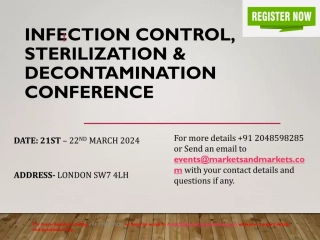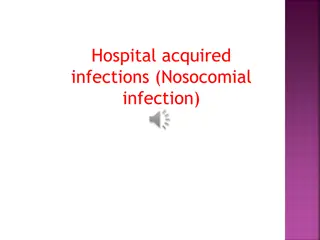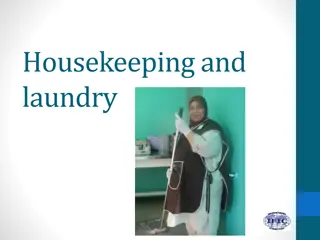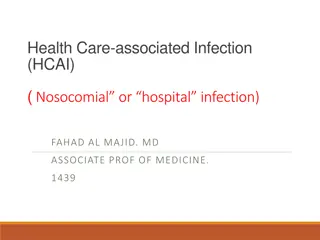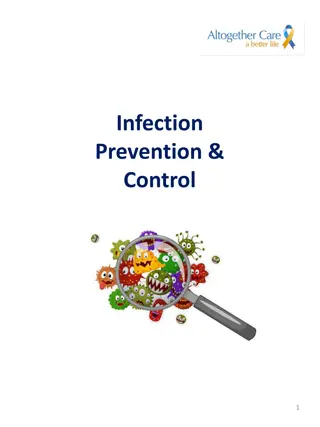Infection Control, Sterilization & Decontamination Event |21st - 22nd March 2024
MarketsandMarkets is pleased to announce its 8th Annual Infection Control, Sterilisation, and Decontamination in Healthcare Conference, which will take place March 21\u201322, 2024, in London, UK. \n\nEnquire Now @ https:\/\/events.marketsandmarkets.com\/infection-control-sterilization-and-decontami
2 views • 5 slides
Infection Control, Sterilization & Decontamination Conference-MarketsandMarkets
MarketsandMarkets is pleased to announce its 8th Annual Infection Control, Sterilisation, and Decontamination in Healthcare Conference, which will take place March 21\u201322, 2024, in London, UK. \n\nEnquire Now @ https:\/\/events.marketsandmarkets.com\/infection-control-sterilization-and-decontami
2 views • 5 slides
The Evolving Landscape of Virtual Wards in Healthcare
The global COVID-19 pandemic has prompted a shift in healthcare delivery towards virtual wards, offering improved patient experiences, enhanced outcomes, and sustainable healthcare solutions. Virtual wards provide healthcare at home, reducing nosocomial infections and optimizing resource utilization
0 views • 26 slides
Healthcare-Associated Infections Prevention Program: Best Practices
This program by the California Department of Public Health focuses on infection prevention practices during resident positioning and transferring in healthcare settings. It addresses implicit bias, hand hygiene, proper positioning importance, prevention of pressure injuries, and strategies to avoid
0 views • 38 slides
Understanding Infection Prevention & Control Measures
Infection prevention and control measures are essential in healthcare settings and beyond to prevent the transmission of infectious diseases. This article covers the basics of infection prevention, routine practices, additional precautions, and resources for further education on the topic.
4 views • 14 slides
Nursing Care for Ventilator-Associated Pneumonia (VAP)
Ventilator-Associated Pneumonia (VAP) is defined as lung parenchyma inflammation occurring 48 hours or more after endotracheal intubation and mechanical ventilation initiation. It is a common nosocomial infection in ICU patients, with significant morbidity and mortality rates. Etiology of VAP involv
2 views • 24 slides
Understanding Nosocomial Infections and Prevention Strategies
Nosocomial infections are microbial diseases that affect patients during hospital stays, with sources including patients, healthcare workers, and hospital environments. Investigations involve isolating organisms and typing them for efficient management. Prevention strategies include sterilization, h
10 views • 8 slides
Understanding Infection: Causes, Signs, and Nursing Management
Learn about the definition of infection, common causes, general and specific signs and symptoms, nursing assessment for foot ulcers and pressure injuries, as well as nursing interventions for infection prevention and management. Dive into the stages of infection, general and specific signs and sympt
0 views • 24 slides
Clinical Skills Lab: Foley Catheterization, Breast & Pelvic Examinations
This informative content covers topics such as urethral catheterization, indications for catheterization, anatomic landmarks, male and female catheterization techniques, nosocomial UTIs, pelvic and breast examinations, breast cancer screening recommendations, and breast cancer statistics. It is a co
1 views • 17 slides
What Are Shingles What Are The Signs & Causes of it
\"Shingles Infection is caused by the varicella-zoster virus. To reduce the risk of this infection, you need to get vaccinated Understanding these causes can help in managing and potentially preventing shingles outbreaks Shingles Infection is caused
0 views • 7 slides
Understanding Proteus Bacteria: Historical Significance, Pathogenesis, and Laboratory Diagnosis
Proteus species, named after the Greek god Proteus, exhibit pleomorphism. Their historical importance stems from the unique characteristics of H and O antigens, with flagellated strains resembling a thin film on agar. Pathogenically, Proteus mirabilis and P. vulgaris are opportunistic pathogens caus
0 views • 12 slides
Understanding Canine Viral Infection: A Comprehensive Overview
Canine Viral Infection, caused by canine parvovirus-2, is a highly contagious disease affecting dogs, especially puppies. The infection spreads through fecal-oral route and can lead to severe clinical signs like vomiting, diarrhea, and dehydration. The virus replicates in lymphoid tissues, affecting
0 views • 11 slides
Update on Mental Health, Infection Prevention, Staff Vaccine, and Testing in NHS England and NHS Improvement
In the agenda for the meeting on 20th November 2020, topics included updates on mental health, staff flu vaccine and testing, infection prevention, and nosocomial infections in NHS England and NHS Improvement. The importance of preventing COVID-19 nosocomial infections was emphasized, along with fac
0 views • 10 slides
Overview of Ancylostoma duodenale (Hookworm) Infection
Ancylostoma duodenale, a parasitic worm causing Ancylostomiasis, is discussed in this lecture. The infection's distribution, morphology, life cycle, and pathology are detailed, emphasizing the impact on humans. The lifecycle stages, including egg production, larval development, and entry into the hu
0 views • 12 slides
Comprehensive Guide to Infection Prevention and Control in Healthcare Facilities
This comprehensive guide outlines the objectives, structure, responsibilities, common sources of infection, and principles of infection prevention and control in healthcare facilities. The program aims to minimize the risk of healthcare-associated infections, enhance healthcare worker adherence to I
0 views • 55 slides
Feline Nematode Infection in Annual Health Visit
Millie, a 4-year-old domestic shorthair cat, was found to have Toxocara cati infection during her routine annual health visit. She was asymptomatic, and the infection was detected through a fecal exam. The treatment plan includes using an FDA-approved drug and recommending a monthly parasite prevent
2 views • 11 slides
Operating Theatre Infection Control Guidelines and Practices
Infection control in operating theatres is crucial to prevent nosocomial infections. The layout, practices, and guidelines outlined by Dr. Chisale Mhango in Malawi emphasize sterilization, cleanliness, and strict protocols for patient safety and staff well-being. Key elements include proper storage
0 views • 34 slides
Importance of Hand Hygiene in Healthcare Settings
Hand hygiene plays a crucial role in preventing nosocomial infections, reducing MRSA incidence, and cutting costs in healthcare facilities. Studies have shown a significant decrease in infection prevalence and MRSA cases, as well as substantial cost reductions with proper hand hygiene practices. Mon
0 views • 10 slides
Comprehensive Guide to Hand Hygiene in Infection Control
Hand hygiene is crucial in infection control, encompassing various methods like routine hand washing, antiseptic hand wash, and surgical hand antisepsis. Different types of hand hygiene include routine, antiseptic, and surgical antisepsis for removing or destroying bacterial infection. Indications f
0 views • 7 slides
Understanding Standardized Infection Ratio (SIR) in Healthcare-Associated Infections
The Standardized Infection Ratio (SIR) is a key measure used to monitor healthcare-associated infections (HAIs) at different levels. It compares observed HAIs with predicted values based on specific risk factors. An SIR > 1 indicates more infections than predicted, an SIR = 1 means observed equals p
0 views • 19 slides
Understanding Standardized Infection Ratio (SIR) in Healthcare
The Standardized Infection Ratio (SIR) is a crucial metric used to monitor Healthcare-Associated Infections (HAIs) at various levels. It allows for improved risk adjustment and comparison by providing a single summary number. Standardization methods like direct and indirect standardization help in a
0 views • 44 slides
Management of C. difficile Infection Testing and Treatment Protocol
Stony Brook has implemented a two-step testing algorithm for C. difficile infection using PCR and EIA tests to differentiate between active infection and asymptomatic carriage. Positive PCR results are further tested with EIA. The protocol includes criteria for CDI testing, specimen collection guide
0 views • 5 slides
Understanding Mechanisms of Viral Infection and Spread
Viral infection involves a replicative cycle within the host, leading to a range of cellular responses from no apparent effect to disease. Factors such as virulence genes, host characteristics, and viral genome influence the pathogenicity and virulence of a virus. The process includes entry into the
0 views • 16 slides
Infection Control and Prevention Guidelines for COVID-19 in Adult Care Facilities
Review the recommendations for infection control, prevention, and isolation of COVID-19 in facilities serving adults provided by the Delaware Department of Health & Social Services. The guidelines cover core principles of infection prevention, general guidance for employees and patients, hand hygien
0 views • 54 slides
Importance of Hand Washing and Respiratory Hygiene in Infection Prevention
Understanding the importance of hand washing and covering coughs/sneezes in preventing the spread of infection is crucial. Through activities like the Toilet Paper Experiment, students can learn about microbial transmission and the significance of personal hygiene practices. Discussions around perso
0 views • 29 slides
Understanding the Epidemic of C. Difficile Infection: Insights and Implications
C. Difficile infection is a growing concern, with a significant impact on public health in the United States. High rates of infection and mortality, particularly among the elderly, highlight the urgent need for effective prevention and management strategies. The burden of C. Difficile infection exte
0 views • 59 slides
Understanding Infection Prevention and Control in Housekeeping and Laundry Settings
This educational material covers the crucial role of infection prevention and control in environmental services, housekeeping, and laundry settings. Key topics include cleaning practices, sources of infection, the importance of the environment, and the use of disinfectants. It emphasizes the signifi
0 views • 28 slides
Understanding Health Care-associated Infections (HCAI) in Hospital Settings
Health care-associated infections (HCAI), also known as nosocomial or hospital infections, are infections that occur in patients during their hospital stay or after discharge. These infections can result from various sources, including colonization by microorganisms and exposure to contaminated envi
0 views • 48 slides
Infection Guidelines for Data Entry Scenarios
Guidelines for entering different infection scenarios into a database, including pre-implant infections, colonization cases, and handling multiple organisms in cultures. Clear instructions on what constitutes a major infection adverse event and how to accurately document various infection situations
0 views • 18 slides
Developing a Surgical Site Infection Bundle for Improved Patient Outcomes
Developing a comprehensive Surgical Site Infection (SSI) bundle to reduce infection rates, including interventions like preoperative chlorhexidine baths, standardized antibiotic protocols, and targeted prophylactic measures. By implementing these strategies, the aim is to lower infection rates below
0 views • 24 slides
Trends in Parasitic Copepod Infection Among Juvenile Salmonids in WVP Reservoirs Study
Study conducted by the Oregon Department of Fish and Wildlife researchers to investigate trends in parasitic copepod infection among juvenile salmonids in WVP reservoirs. The study focuses on the prevalence and intensity of infection on the gills, comparing infection levels between stream-rearing an
0 views • 12 slides
Overview of Hepatitis B Infection in Ireland: Epidemiology, Transmission, and Prevention
Hepatitis B infection is a viral liver disease transmitted through various means such as contact with infected body fluids. The virus can lead to acute or chronic infection, potentially causing severe liver complications. Vaccination programs and lifelong treatment options aim to manage and prevent
0 views • 30 slides
Vaccination Status and Influenza Infection Among Pregnant Japanese Women
This study explores the impact of seasonal influenza vaccination on infection rates among pregnant Japanese women, focusing on primiparous and multiparous individuals. It discusses the background of influenza-related complications in pregnant women, presenting data on maternal mortality during the H
0 views • 30 slides
Antimicrobial Prophylaxis for Surgical Site Infection Prevention in Orthopedics
Surgical site infections (SSIs) are common and costly healthcare-associated infections, accounting for a significant percentage of nosocomial infections. Defined by the CDC, SSIs occur within 30 days of surgery and have clinical criteria such as purulent exudate, positive cultures, or surgeon diagno
0 views • 10 slides
Comprehensive Guide to Infection Prevention and Control
Understanding the essentials of infection prevention and control is crucial in healthcare settings. This guide covers key topics such as basic principles, standard precautions, specific infections, surveillance, and prevention methods. It explores the chain of infection, factors making individuals s
0 views • 65 slides
Understanding Infection Prevention and Control for COVID-19 in Healthcare
Infection prevention and control aim to prevent harm from infections to patients and healthcare workers, based on scientific principles and patient safety. The content discusses human coronaviruses, modes of transmission, risk factors, and the role of infection prevention in healthcare settings.
0 views • 43 slides
Building a Business Case for Infection Prevention in Healthcare
Explore the essential reasons for a business case in infection prevention, focusing on market forces, economic viability, and the need to demonstrate value to healthcare administrators. Understand the critical role of infection control programs in healthcare facilities and the importance of cost eff
0 views • 46 slides
Guidelines for Suspecting and Managing 2019-nCoV (COVID-19) Infection
Guidelines provided by the Ministry of Public Health in Lebanon highlight the criteria for suspecting a 2019-nCoV (COVID-19) infection, including illness onset and exposure factors. It outlines symptoms to look for, such as fever and respiratory issues, as well as exposure scenarios like travel to C
0 views • 23 slides
Importance of Infection Prevention and Control in Healthcare
Infection Prevention and Control is crucial to safeguarding against the spread of harmful microorganisms in healthcare settings. This comprehensive guide covers the definition of infections, types of microorganisms, modes of transmission, the immune system's role, factors predisposing to infections,
0 views • 7 slides
Environmental Issues in Infection Prevention: Addressing Challenges and Best Practices
Addressing environmental issues in infection prevention is crucial for maintaining a safe healthcare facility. The challenges include room cleaning during hospitalization, disinfection post-discharge/transfer, time constraints, cost containment, ongoing education, competency assessment, and outcome
0 views • 19 slides

